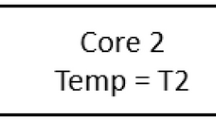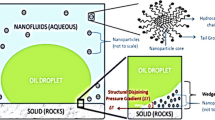Abstract
The development of oil and gas resources in low-permeability reservoirs is being paid more and more attention. Moreover, oil and gas resources in low-permeability reservoirs are affluent, and the water cut of the medium permeability layer is so high that the injection capacity has decreased significantly. Therefore, it is of great importance to address the issues of injectability and enhance oil recovery in low-permeability reservoirs. Given the existing conditions of low permeability and high water cut in Daqing Oilfield, the synthesis of an in situ emulsified associative polymer (ISEPAM) is the focus of the research. The polymer was prepared by micellar polymerization, ensuring a molecular weight of 5 × 106 Dalton. A series of experiments were conducted to investigate its dissolution filtration property, viscosifying, emulsification, anti-adsorption, conductivity, and oil displacement capacity. The experimental results show that ISEPAM has more significant properties than the polymeric surfactant (HB) used in Daqing Oilfield. The ISEPAM solution has significant filterability (filter factor is 1.1), viscosifying (38.66 mPa·s), emulsification (the water evolution rate of ISEPAM was only 4.4% for 60 min at 90% water cut), and good anti-adsorption property (after five adsorptions, still has a viscosity retention rate of 65%) in a specific concentration (1000 mg/L) and the field water in Daqing Oilfield (salinity is 4996.3 mg/L). The reason for this is due to the presence of dynamic reversible networks in the ISEPAM solution, and there are no cationic functional groups on the polymer chain. The conductivity of ISEPAM was tested using a homogeneous square core with 48.1 mD permeability, and the results show that the viscosity retention rate of the effluent can reach 90% and excellent injection property can be achieved. In the oil displacement test, ISEPAM presents excellent sweep efficiency and enhanced oil recovery by about 25% under 50 mD permeability. Under low permeability conditions, the ISEPAM exhibits better injectability and excellent oil displacement capacity. The related findings can provide an important idea and reference for the design and development of EOR polymers in the reservoirs with low permeability or high water cut.













Similar content being viewed by others
Availability of data and materials
All of the material is owned by the authors and no permissions are required.
References
Kang W, Zhou B, Issakhov M, Gabdullin M (2022) Advances in enhanced oil recovery technologies for low permeability reservoirs. Pet Sci 19(4):1622–1640. https://doi.org/10.1016/j.petsci.2022.06.010
Cong L, Li WL, Lei JC, Li RB (2013) The current situation and prospects of development of low permeability oil reservoir. Adv Mater Res 734–737:1286–1289. https://doi.org/10.4028/www.scientific.net/AMR.734-737.1286
Rezaei A, Bagherpour S (2022) Chapter 11 Formation damage during chemical flooding. In: Chemical methods. https://doi.org/10.1016/B978-0-12-821931-7.00006-7
Sun L, Wu X, Wanfu Z, Li X, Han P (2018) Technologies of enhancing oil recovery by chemical flooding in Daqing Oilfield, NE China. Pet Explor Dev 45(4):673–684. https://doi.org/10.1016/S1876-3804(18)30071-5
Wang Z, Cao G, Bai Y, Wang P, Wang X (2023) Current situation and prospect of enhanced oil recovery technology in low permeability reservoir. Special Oil Gas Reserv 30(01):1–13
Wang Y, Liu H, Wang J, Dong X, Chen F (2019) Formulation development and visualized investigation of temperature-resistant and salt-tolerant surfactant-polymer flooding to enhance oil recovery. J Pet Sci Eng 174:584–598. https://doi.org/10.1016/j.petrol.2018.11.074
Yuan S, Wang Q (2018) New progress and prospect of oilfields development technologies in China. Pet Explor Dev 45(4):698–711. https://doi.org/10.1016/S1876-3804(18)30073-9
Dong M, Ma S, Liu Q (2009) Enhanced heavy oil recovery through interfacial instability: a study of chemical flooding for Brintnell heavy oil. Fuel 88(6):1049–1056. https://doi.org/10.1016/j.fuel.2008.11.014
Feng H, Kang W, Zhang L, Chen J, Li Z, Zhou Q, Wu H (2018) Experimental study on a fine emulsion flooding system to enhance oil recovery for low permeability reservoirs. J Pet Sci Eng 171:974–981. https://doi.org/10.1016/j.petrol.2018.08.011
Park H, Han J, Sung W (2015) Effect of polymer concentration on the polymer adsorption-induced permeability reduction in low permeability reservoirs. Energy 84:666–671. https://doi.org/10.1016/j.energy.2015.03.028
Guo Y, Hu J, Zhang X, Feng R, Li H (2016) Flow behavior through porous media and microdisplacement performances of hydrophobically modified partially hydrolyzed polyacrylamide. SPE J 03(21):688–705
Guo Y, Zhang J, Zhang X, Hu J, Wang W, Liang Y (2018) Investigation and application of an associative polymer-surfactant binary system for a successful flooding pilot in a high-temperature, high-salinity, ordinary heavy oil reservoir. In: SPE EOR conference at oil & gas west asia
Rezaeiakmal F, Parsaei R, Shafiabadi A, Rezaei A (2022) Insights into the flow behaviour of the pre-generated polymer enhanced foam in heterogeneous porous media during tertiary oil recovery: effect of gravitational forces. J Pet Sci Eng 213:110385. https://doi.org/10.1016/j.petrol.2022.110385
Asemani M, Rezaei A (2022) Chapter 9 - Combination of chemical methods. In: Abdolhossein Hemmati-Sarapardeh MSMR (ed) Chemical methods. pp 401–431. https://doi.org/10.1016/B978-0-12-821931-7.00005-5
Weidong LI, Litao LU, Guangzhi LI, Luo Z, Yunyun W, Jiang W (2017) Experimental study on the mechanism of enhancing oil recovery by polymer – surfactant binary flooding. Pet Explor Dev 44(4):636–643. https://doi.org/10.1016/S1876-3804(17)30072-1
Li Z, Zhang W, Tang Y, Li B, Song Z, Hou J (2016) Formation damage during alkaline-surfactant-polymer flooding in the sanan-5 block of the Daqing Oilfield, China. J Nat Gas Sci Eng 35:826–835. https://doi.org/10.1016/j.jngse.2016.07.046
Liu Z, Li Y, Lv J, Li B, Chen Y (2017) Optimization of polymer flooding design in conglomerate reservoirs. J Pet Sci Eng 152:267–274. https://doi.org/10.1016/j.petrol.2017.03.010
Wang G (2018) Microscopic residual oil utilization mechanism of low viscosity polymer flooding in low permeability reservoir. Fault Block Oil Gas Field 25(6):776–780. https://doi.org/10.6056/dkyqt201806018
Pei H, Zhang G, Ge J, Jiang P, Zhang J, Zhong Y (2017) Study of polymer-enhanced emulsion flooding to improve viscous oil recovery in waterflooded heavy oil reservoirs. Colloids Surf A 529:409–416
Massarweh O, Abushaikha AS (2020) The use of surfactants in enhanced oil recovery: a review of recent advances. Energy Rep 6:3150–3178. https://doi.org/10.1016/j.egyr.2020.11.009
Li Z, Yun Q, Tang W, Liu Z, Guo Y, Lou Q (2020) Phase behavior of petroleum sulfonate and the effect of its emulsification on enhanced oil recovery. Oilfield Chem 37(3):468–473. https://doi.org/10.19346/j.cnki.1000-4092.2020.03.016
Zhe L. Study on spontaneous emulsification flooding system for low permeability reservoirs. PhD: China University of Petroleum
Wang FL, Sha ZL, Luo Q, Zhao YF, Zhang JF (2019) Progress and prospects of the develo** techniques in ultra-high water-cut period of Daqing Oilfield. Pet Geol Oilfield Dev Daqing 38(5):51–58. https://doi.org/10.19597/J.ISSN.1000-3754.201908025
Fa-Jiang R (2013) Study on chemical structure of polymer surfactant for enhanced oil recovery. Chem Eng 27(11):19–22
C. National Energy Administration. Technical criterions of polymer for oil displacement. SY/T 5862-2020. pp 14–15
Guo Y, Zhang J, Zhang X, Hu J, Wang W, Liang Y (2018) Investigation and application of an associative polymer-surfactant binary system for a successful flooding pilot in a high-temperature, high-salinity, ordinary heavy oil reservoir. SPE. https://doi.org/10.2118/190411-MS
Liu R, Pu W, Du D (2017) Synthesis and characterization of core-shell associative polymer that prepared by oilfield formation water for chemical flooding. J Ind Eng Chem 46:80–90. https://doi.org/10.1016/j.jiec.2016.10.018
Lu Y, Wu H, Meng Z, Jiang J, ** Y, Deng Z, Su W, Li Z, Kang W (2018) Salt effect on hydrophobically modified polyacrylamide-containing crude oil emulsions: stability and rheology study. Colloid Polym Sci 296(3):515–527. https://doi.org/10.1007/s00396-018-4267-1
Lai X, Liu G, Liu Y, Dong X, Liu X, Mukhtar Y, Wang L, Wen X, Lu L (2023) Preparation and viscoelasticity of novel hydrophobic associating polymer with salt stimulation responsiveness by functional monomer modification for fracturing fluids. Colloid Polym Sci 301(10):1271–1283. https://doi.org/10.1007/s00396-023-05150-w
Feng Y (1999) Study on solution structure of hydrophobically associating water-soluble polymer and its effect on solution rheology. PhD: Southwest Petroleum University
Feng R (2008) Study on the relationship of molecular structure, solution structure rheological properties of hydrophobically associating water-soluble polymers. PhD: Southwest Petroleum University
Ye Z, Zhang X, Chen H, Han L, Jiang J, Song J, Yuan J (2015) Synthesis and evaluation of a class of sulfonic water soluble polymer with high content of nonionic surfmer units. Colloid Polym Sci 293(8):2321–2330. https://doi.org/10.1007/s00396-015-3609-5
Karambeigi MS, Abbassi R, Roayaei E, Emadi MA (2015) Emulsion flooding for enhanced oil recovery: interactive optimization of phase behavior, microvisual and core-flood experiments. J Ind Eng Chem 29(25):382–391
Ma B, Gao B, Yue Q (2013) Study on emulsification stability of wastewater produced by polymer flooding. J Pet Sci Eng 110:27–31. https://doi.org/10.1016/j.petrol.2013.08.044
Sun W, Sun D, Wei Y, Liu S, Zhang S (2007) Oil-in-water emulsions stabilized by hydrophobically modified hydroxyethyl cellulose: adsorption and thickening effect. J Colloid Interface Sci 311(1):228–236. https://doi.org/10.1016/j.jcis.2007.02.082
Wibowo ADK, Yoshi LA, Handayani AS, Joelianingsih (2021) Synthesis of polymeric surfactant from palm oil methyl ester for enhanced oil recovery application. Colloid Polym Sci 299(1):81–92. https://doi.org/10.1007/s00396-020-04767-5
Liu Q, Dong M, Zhou W, Ayub M, Zhang YP, Huang S (2004) Improved oil recovery by adsorption–desorption in chemical flooding. J Pet Sci Eng 43(1–2):75–86. https://doi.org/10.1016/j.petrol.2003.12.017
Wang C, Liu P, Wang Y, Yuan Z, Xu Z (2018) Experimental study of key effect factors and simulation on oil displacement efficiency for a novel modified polymer bd-hmhec. Sci Rep 8(1). https://doi.org/10.1038/s41598-018-22259-z
Pogaku R, Mohd Fuat NH, Sakar S, Cha ZW, Musa N, Awang Tajudin DN, Morris LO (2018) Polymer flooding and its combinations with other chemical injection methods in enhanced oil recovery. Polym Bull 75(4):1753–1774. https://doi.org/10.1007/s00289-017-2106-z
Ding M, Han Y, Liu Y, Wang Y, Zhao P, Yuan Y (2019) Oil recovery performance of a modified HAPAM with lower hydrophobicity, higher molecular weight: a comparative study with conventional HAPAM, HPAM. J Ind Eng Chem 72:298–309. https://doi.org/10.1016/j.jiec.2018.12.030
Zhang F, Ouyang J, Ma X, Zhang H, Wang D, Feng X (2012) Enhanced oil recovery from heavy oil reservoirs utilizing a displacement agent. Chem Tech Fuels Oils 48:202–207
Acknowledgements
We are grateful that the College of New Energy and Materials, Southwest Petroleum University provided the measuring tools and laboratories.
Funding
The authors would like to acknowledge the College of New Energy and Materials, Southwest Petroleum University for the financial support of this work.
Author information
Authors and Affiliations
Contributions
The manuscript was written through the contributions of all authors. All authors have approved the final version of the manuscript. CJ: conceptualization, methodology, and validation. C-jN: conceptualization, methodology, investigation, and writing—original draft preparation. Y-jG: conceptualization and validation. LY: data curation and writing—original draft preparation. JH: data curation and writing—original draft preparation. JL: data curation. Q-yX: data curation.
Corresponding authors
Ethics declarations
Ethical approval
This declaration is not applicable. Our research does not need to use humans or animals as research objects.
Conflict of interest
The authors declare no competing interests.
Additional information
Publisher's Note
Springer Nature remains neutral with regard to jurisdictional claims in published maps and institutional affiliations.
Rights and permissions
Springer Nature or its licensor (e.g. a society or other partner) holds exclusive rights to this article under a publishing agreement with the author(s) or other rightsholder(s); author self-archiving of the accepted manuscript version of this article is solely governed by the terms of such publishing agreement and applicable law.
About this article
Cite this article
**, C., Nie, Cj., Guo, Yj. et al. Research on the properties of in situ emulsified active associative polymer with low molecular weight based on low permeability oil reservoirs. Colloid Polym Sci 302, 679–694 (2024). https://doi.org/10.1007/s00396-023-05220-z
Received:
Revised:
Accepted:
Published:
Issue Date:
DOI: https://doi.org/10.1007/s00396-023-05220-z




